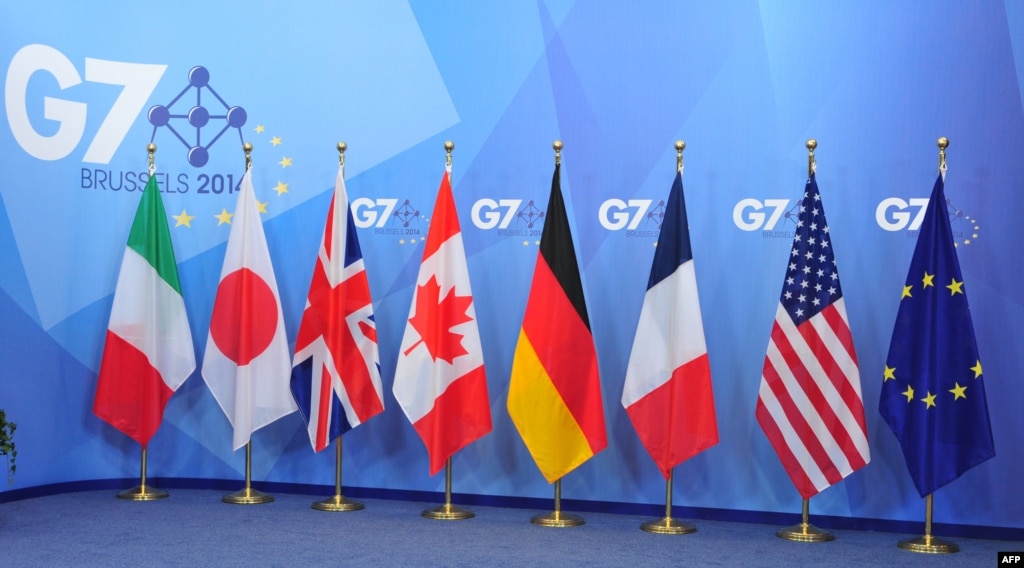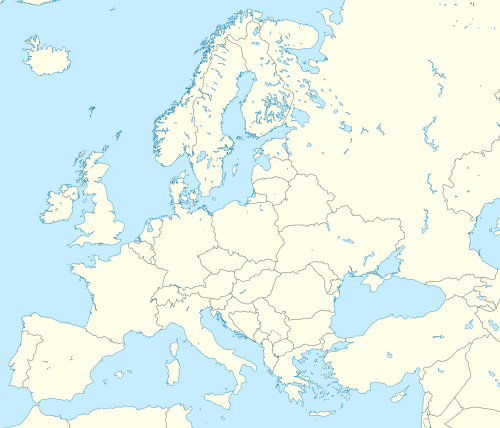ALL YOU NEED TO KNOW ABOUT G7(GROUP OF 7)
SHARE THIS

INTRODUCTION
The Group of 7 (G7) is a group consisting of the finance ministers and central bank governors of seven major advanced economies as reported by the International Monetary Fund: Canada, France, Germany, Italy, Japan, the United Kingdom, and the United States meeting to discuss primarily economic issues. The European Union is also represented within the G7. Contrary to popular belief the G7 are not the 7 countries with the highest GDP in the World.[1] However the G7 countries do represent more than 64% of the net global wealth ($263 trillion) according to the Credit Suisse Global Wealth Report October 2014[2][page needed], 46% of the global nominal gdp [3] and 32% of the global purchasing power parity gdp [4]. The IMF's Managing Director usually participates.[5]
The next major G7 summit will be held in 2016 in Japan. Other recent G7 meetings include that of May 2013 in Aylesbury, United Kingdom with an emergency meeting in The Hague, Netherlands on March 24, 2014. Most recently, the 41st G7 summit was held at the Schloss Elmau hotel in Krün, Germany on June 7–8, 2015.[6]
Following 1994's G7 summit in Naples, Russian officials held separate meetings with leaders of the G7 after the group's summits. This informal arrangement was dubbed the Political 8 (P8) – or, colloquially, the G7+1. At the invitation of Prime Minister of the United Kingdom Tony Blair and President of the United States Bill Clinton,[8] Russian President Boris Yeltsin was invited first as a guest observer, later as a full participant. It was seen as a way to encourage Yeltsin's capitalist reforms.[citation needed] After the 1997 meeting Russia was formally invited to the next meeting and formally joined the group in 1998, resulting in a new group, the Group of Eight, or G8.[7]
In 1996, the G7 launched an initiative for the 42 heavily indebted poor countries (HIPC).[11]
In 1999, the G7 decided to get more directly involved in "managing the international monetary system" through the Financial Stability Forum, formed earlier in 1999 and the G-20, established following the summit, to "promote dialogue between major industrial and emerging market countries".[12] In 1999 the G7 announced their plan to cancel 90% of bilateral, and multilateral debt for the HIPC, totaling $100 billion.[citation needed] In 2005 the G7 announced, debt reductions of "up to 100%" to be negotiated on a "case by case" basis.[citation needed]
In 2008 the G7 met twice in Washington, D.C. to discuss the global financial crisis of 2007-2010[13] and in February 2009 in Rome.[14][15] The group of finance ministers pledged to take "all necessary steps" to stem the crisis.[16]
On March 2, 2014, the G7 condemned the "Russian Federation's violation of the sovereignty and territorial integrity of Ukraine."[17] The G7 stated "that the International Monetary Fund(IMF) remains the institution best prepared to help Ukraine address its immediate economic challenges through policy advice and financing, conditioned on needed reforms", and that the G7 was "committed to mobilize rapid technical assistance to support Ukraine in addressing its macroeconomic, regulatory and anti-corruption challenges."[17]
On March 24, 2014, the G7 convened an emergency meeting in response to the Russian Federation's annexation of Crimea at the Dutch Catshuis, located in The Hague because all G7 leaders were already present to attend the 2014 Nuclear Security Summit. This was the first G7 meeting neither taking place in a member nation nor having the host leader participating in the meeting.[18]
On June 4, 2014 leaders at the G7 summit in Brussels, condemned Moscow for its "continuing violation" of Ukraine's sovereignty, in their joint statement and stated they were prepared to impose further sanctions on Russia.[19] This meeting was the first since Russia was expelled from the group following its annexation of Crimea in March.[19]
Significant police deployment has become a hallmark of G7 meetings since the violent demonstrations at the 27th G8 summit in Genoa 2001 and the 33rd G8 summit in Heiligendamm 2007 : Two weeks before the Elmau meeting, German police suspended the Schengen protocol to perform "flexible border controls", which included not only road, train and air traffic, but also the so called "Grüne Grenze" of hiking paths, especially from Czech Republic and Austria. The expected 11,000 demonstrators will face 17,000 policemen.[24]
The annual G7 leaders summit is attended by the heads of government.[25] The member country holding the G7 presidency is responsible for organizing and hosting the year's summit.
The serial annual summits can be parsed chronologically in arguably distinct ways, including as the sequence of host countries for the summits has recurred over time, series, etc.[26]

INTRODUCTION
The Group of 7 (G7) is a group consisting of the finance ministers and central bank governors of seven major advanced economies as reported by the International Monetary Fund: Canada, France, Germany, Italy, Japan, the United Kingdom, and the United States meeting to discuss primarily economic issues. The European Union is also represented within the G7. Contrary to popular belief the G7 are not the 7 countries with the highest GDP in the World.[1] However the G7 countries do represent more than 64% of the net global wealth ($263 trillion) according to the Credit Suisse Global Wealth Report October 2014[2][page needed], 46% of the global nominal gdp [3] and 32% of the global purchasing power parity gdp [4]. The IMF's Managing Director usually participates.[5]
The next major G7 summit will be held in 2016 in Japan. Other recent G7 meetings include that of May 2013 in Aylesbury, United Kingdom with an emergency meeting in The Hague, Netherlands on March 24, 2014. Most recently, the 41st G7 summit was held at the Schloss Elmau hotel in Krün, Germany on June 7–8, 2015.[6]
History
The G7's precursor was the 'Group of Six', founded ad hoc in 1975, consisting of finance ministers and central bank governors from France, West Germany, Italy, Japan, the United Kingdom and the United States, when Giscard d'Estaing invited them for an "informal gathering at the chateau of Rambouillet, near Paris [...] in a relaxed and private setting".[7] The intent was "to discuss current world issues (dominated at the time by the oil crisis) in a frank and informal manner".[7] Canada became the seventh member in 1976, after which the name 'Group 7' or G7 was used.[7] During 1986–87 the G7 with its finance ministers and central bank governors superseded the G5 as the main policy coordination group, particularly following the Louvre Accord of February 1987, agreed by the G5 plus Canada and endorsed by the G7.Following 1994's G7 summit in Naples, Russian officials held separate meetings with leaders of the G7 after the group's summits. This informal arrangement was dubbed the Political 8 (P8) – or, colloquially, the G7+1. At the invitation of Prime Minister of the United Kingdom Tony Blair and President of the United States Bill Clinton,[8] Russian President Boris Yeltsin was invited first as a guest observer, later as a full participant. It was seen as a way to encourage Yeltsin's capitalist reforms.[citation needed] After the 1997 meeting Russia was formally invited to the next meeting and formally joined the group in 1998, resulting in a new group, the Group of Eight, or G8.[7]
Function
The organization was originally founded to facilitate shared macroeconomic initiatives by its members in response to the collapse of the exchange rate 1971, during the time of the Nixon Shock, the 1970s energy crisis and the ensuing recession.[9] Its goal was fine tuning of short term economic policies among participant countries to monitor developments in the world economy and assess economic policies.[citation needed]Work
Since 1975, the group meets annually on summit site to discuss economic policies; since 1987, the G7 finance ministers have met at least semi-annually, up to 4 times a year at stand-alone meetings.[5][10]In 1996, the G7 launched an initiative for the 42 heavily indebted poor countries (HIPC).[11]
In 1999, the G7 decided to get more directly involved in "managing the international monetary system" through the Financial Stability Forum, formed earlier in 1999 and the G-20, established following the summit, to "promote dialogue between major industrial and emerging market countries".[12] In 1999 the G7 announced their plan to cancel 90% of bilateral, and multilateral debt for the HIPC, totaling $100 billion.[citation needed] In 2005 the G7 announced, debt reductions of "up to 100%" to be negotiated on a "case by case" basis.[citation needed]
In 2008 the G7 met twice in Washington, D.C. to discuss the global financial crisis of 2007-2010[13] and in February 2009 in Rome.[14][15] The group of finance ministers pledged to take "all necessary steps" to stem the crisis.[16]
On March 2, 2014, the G7 condemned the "Russian Federation's violation of the sovereignty and territorial integrity of Ukraine."[17] The G7 stated "that the International Monetary Fund(IMF) remains the institution best prepared to help Ukraine address its immediate economic challenges through policy advice and financing, conditioned on needed reforms", and that the G7 was "committed to mobilize rapid technical assistance to support Ukraine in addressing its macroeconomic, regulatory and anti-corruption challenges."[17]
On March 24, 2014, the G7 convened an emergency meeting in response to the Russian Federation's annexation of Crimea at the Dutch Catshuis, located in The Hague because all G7 leaders were already present to attend the 2014 Nuclear Security Summit. This was the first G7 meeting neither taking place in a member nation nor having the host leader participating in the meeting.[18]
On June 4, 2014 leaders at the G7 summit in Brussels, condemned Moscow for its "continuing violation" of Ukraine's sovereignty, in their joint statement and stated they were prepared to impose further sanctions on Russia.[19] This meeting was the first since Russia was expelled from the group following its annexation of Crimea in March.[19]
Influence
The G7 has influenced IMF and World Bank rules of crisis resolution and development, as well as GATT's rules of international trade.[20]Criticism
The G7 has been criticized for its growing representational deficit.[21] The G7 does not include four of the world's eleven largest economies (Brazil, India, Russia, and the world's 2nd largest economy, China, collectively the BRIC). Canada, who is in the G7, actually lies 11th in a list of countries ranked by their GDP. [22] Walden Bello calls the G7 an undemocratic institution.[23] The G7 decision making process has been described non-transparent, by former insider Leo Van Houtven, Secretary of the IMF from 1977 to 1996: "[The G7's] frequent contacts with IMF management on both policy and operational issues lack transparency..."[12]Significant police deployment has become a hallmark of G7 meetings since the violent demonstrations at the 27th G8 summit in Genoa 2001 and the 33rd G8 summit in Heiligendamm 2007 : Two weeks before the Elmau meeting, German police suspended the Schengen protocol to perform "flexible border controls", which included not only road, train and air traffic, but also the so called "Grüne Grenze" of hiking paths, especially from Czech Republic and Austria. The expected 11,000 demonstrators will face 17,000 policemen.[24]
Table of meetings
Host venues of G7 summits in North America
Host venues of G7 summits in Europe
Host venues of G7 summits in Japan
The serial annual summits can be parsed chronologically in arguably distinct ways, including as the sequence of host countries for the summits has recurred over time, series, etc.[26]














0 comments:
DROP YOUR COMMENT